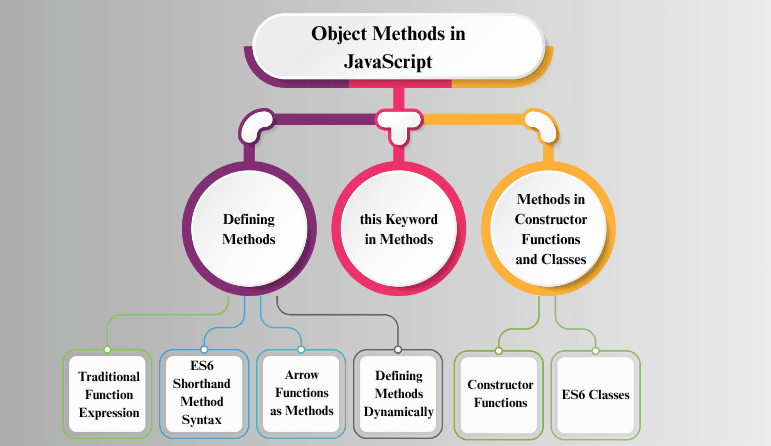Object Methods in JavaScript
In JavaScript, object methods are functions stored as properties of an object. They allow objects to encapsulate behavior, enabling them to perform actions or computations related to their data. This section covers defining methods, usage of this .
What are Object Methods?
- A method is a function assigned to a property of an object.
- Methods typically use the object’s properties to perform tasks.
- They are similar to regular functions but are attached to objects and often use the
thiskeyword to reference the object’s data.

Defining Methods
There are multiple ways to define methods in JavaScript:
a) Traditional Function Expression
Assign a function expression to a property using the function keyword.
const person = {
name: "John",
greet: function() {
console.log(`Hello, I'm ${this.name}`);
}
};
person.greet(); // "Hello, I'm John"
b) ES6 Shorthand Method Syntax
Define methods directly in object literals without the function keyword.
const person = {
name: "John",
greet() {
console.log(`Hello, I'm ${this.name}`);
}
};
person.greet(); // "Hello, I'm John"
c) Arrow Functions as Methods
Caution:
- Arrow functions do not have their own
this. - They inherit
thisfrom the surrounding lexical scope. - Avoid using arrow functions for methods that rely on
this. - Suitable for methods that don’t need
thisor as callbacks inside methods.
const person = {
name: "John",
greet: () => {
console.log(`Hello, I'm ${this.name}`);
}
};
person.greet(); // "Hello, I'm undefined"
d) Defining Methods Dynamically
Methods can be added after object creation:
const person = { name: "John" };
person.greet = function() {
console.log(`Hello, I'm ${this.name}`);
};
person.greet(); // "Hello, I'm John"
Computed Property Names (ES6+):
const methodName = "sayHi";
const person = {
name: "John",
[methodName]() {
console.log(`Hi, I'm ${this.name}`);
}
};
person.sayHi(); // "Hi, I'm John"
The this Keyword in Methods
In a method, this refers to the object the method is called on.
const person = {
name: "Alice",
greet() {
console.log(`Hello, I'm ${this.name}`);
}
};
person.greet(); // "Hello, I'm Alice"
Context Loss:
Extracting a method may lose its this context:
const greet = person.greet;
greet(); // "Hello, I'm undefined" or TypeError in strict mode
Solutions:
Bind the method:
const boundGreet = person.greet.bind(person);
boundGreet(); // "Hello, I'm Alice"
Use .call() or .apply():
greet.call(person); // "Hello, I'm Alice"
Wrap in a function for callbacks:
setTimeout(function() {
person.greet();
}, 1000); // "Hello, I'm Alice" after 1 second
Methods in Constructor Functions and Classes
a) Constructor Functions
Per-instance methods:
function Person(name) {
this.name = name;
this.greet = function() {
console.log(`Hello, I'm ${this.name}`);
};
}
const john = new Person("John");
john.greet(); // "Hello, I'm John"
Prototype methods (shared across instances): Prototype methods are more memory-efficient for multiple instances.
Person.prototype.greet = function() {
console.log(`Hello, I'm ${this.name}`);
};
const alice = new Person("Alice");
alice.greet(); // "Hello, I'm Alice"
b) ES6 Classes
Methods defined inside the class are automatically added to the prototype:
class Person {
constructor(name) {
this.name = name;
}
greet() {
console.log(`Hello, I'm ${this.name}`);
}
}
const bob = new Person("Bob");
bob.greet(); // "Hello, I'm Bob"

